1lumen selects and reviews products personally. We may earn affiliate commissions through our links, which help support our testing.
Speras T3R review
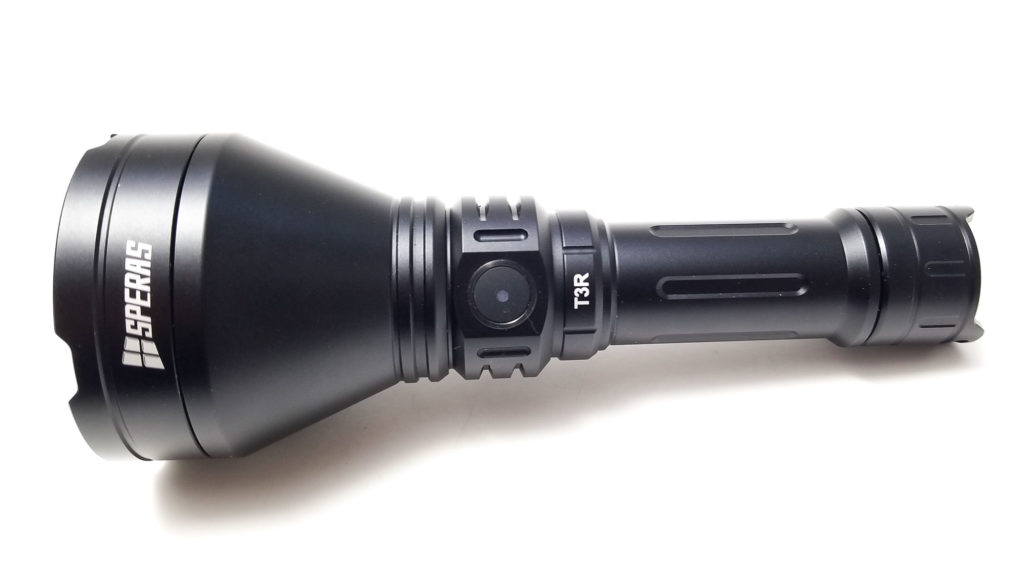
Speras T3R specifications
| Brand/model | Speras T3R |
|---|---|
| LED | Luminus SFT-T40-W |
| Max. Lumens | 1,600 lm |
| Max. Beam intensity / distance | 300,000 cd |
| Battery config. | 1*21700 |
| Onboard charging | USB-C |
| Modes | 4 |
| Blinkies | Strobe / SOS |
| Reflector | Smooth |
| Waterproof | IPX8 |
| Review date | April 2022 |
Introduction:
Speras, or Shenzen Speras Lighting Co. Ltd. is one of the larger, albeit more obscure members of the flashlight continuum. A bit of trivia: The name Speras is derived from the Latin word Spero, which means hope. Speras definitely has a lot to be hopeful for, since they produce a variety of lights tailored for diverse uses, but are mainly known for higher-end EDC and tactical-use (E-series), and T-series, which are larger, long-range outdoor sports (hunting, spotting), or search and rescue flashlights. Speras lights occupy a corner of the market generally inhabited by Olight, Fenix, Nitecore, and Klarus, so you get a nice light with premium features.
I’ve reviewed their E3 mid-range tactical-use/duty light, and it remains a solid choice in that segment despite staunch competition from Olight, Brinyte, Acebeam, Fenix, and Nitecore. Speras was kind enough to send out something new from the T-Series lights, the T3R. Speras dubs this one a “high-performance noiseless flashlight,” meant for long-range observing, hunting, or tactical/duty use (like search and rescue) with features conducive to those roles. There’s some pretty awesome (and affordable…read on), long-range tactical-use/duty lights floating around from Olight and Acebeam, and even Convoy, so let’s see how it stacks up.
Package quality.
As higher-end lights, I expected a higher-end package, and Speras obliged. The T3R comes in an elegant lift-off top box with a crinkle finish with the Speras logo in gold relief on top. It’s easily retail-friendly, and inside, the T3R was mounted in the included holster sitting in a dense foam cradle of sorts with the accessories and manual to the side. Since the T3R can double as a power bank, Speras includes a nicely-executed adapter in the form of a dongle.
- Speras T3R
- Speras S50 5000 mAh 21700 (mounted in the light)
- 2 spare o-rings
- Holster
- Lanyard
- Manual
- USB type C charging cable
- USB OTG power bank adapter dongle
Overall, this is expected in a flashlight of this type and price. It’s RTR (ready-to-run) and has everything needed to open the box, charge the battery (it’s too low to use the High mode), and get on with it. The accessories are nice and seem high quality, especially the USB adapter. The battery was installed with a plastic isolator in the tail to break the connection to keep it from dumping, and the storage voltage was right at 3.6 volts. The lens had a plastic film on it to protect it in transit as well.
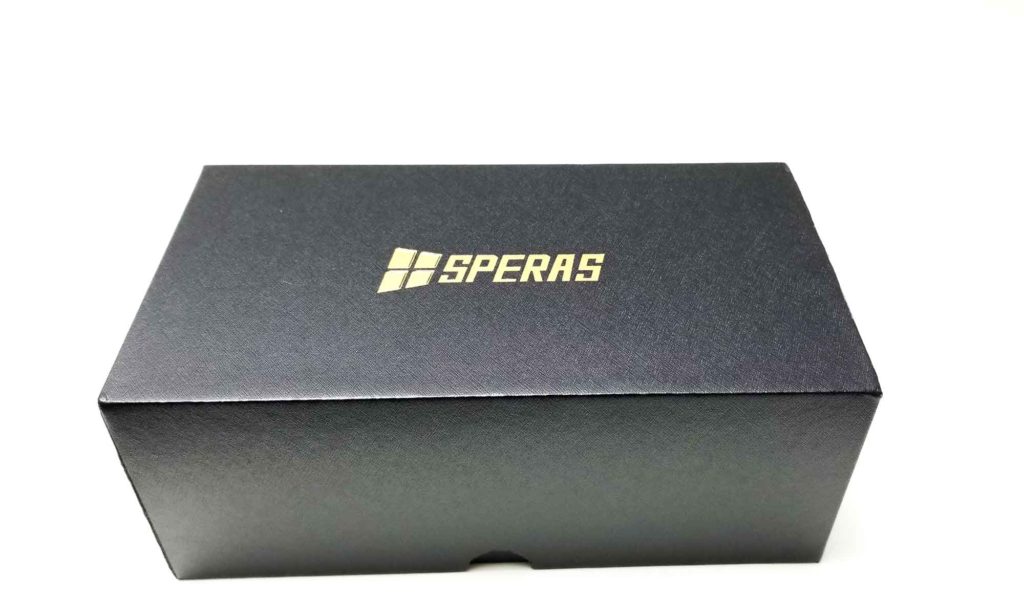
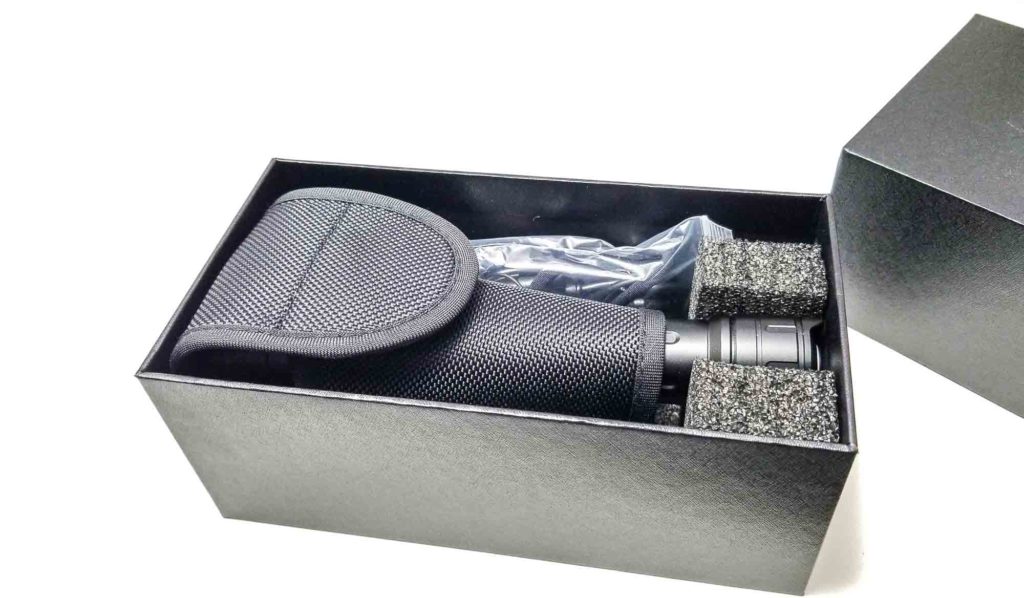
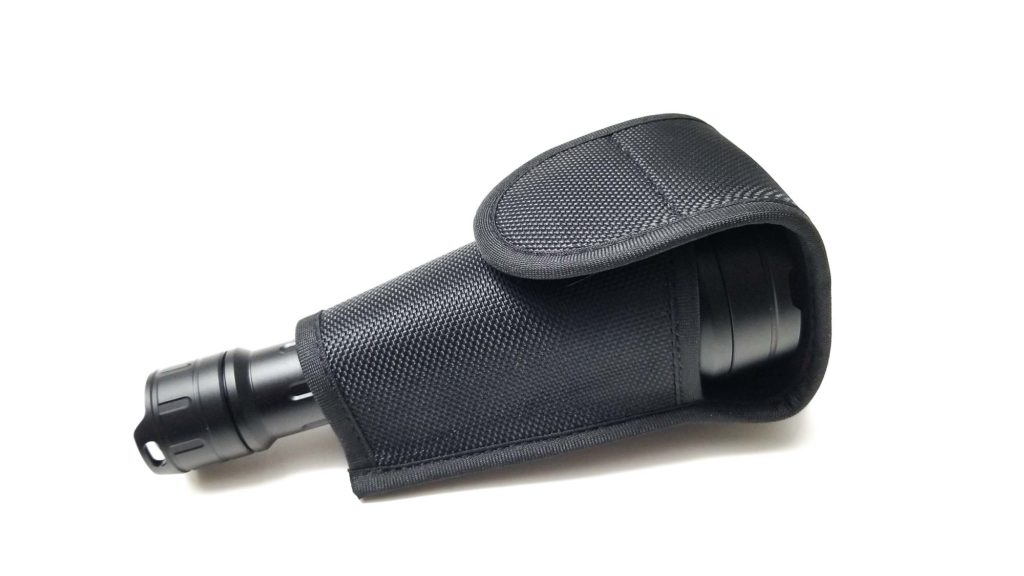
Flashlight in use
The Speras T3R is a compact long-range thrower that can also be used as a general purpose, tactical, or duty light (long-range observing or inspection). I think the T3R would appeal to hunters since it can be mounted to a rifle with 1” scope rings.
It’s definitely not a pocket or EDC light, but with the included holster, would happily ride on a belt. The closest light in size to the T3R is the Convoy L21B, so imagine that light with a side switch and that’s about how the T3R handles. The tube is 21700-size, and just right for most hand sizes, and the balance point is midline with the switch, so it points naturally and would be great for under or overhand use. There’s no tactical ring for a cigar grip, but due to the front-heavy nature, that wouldn’t be particularly comfortable anyway. There’s no knurling or texturing on the tube or tailcap, but there are longitudinal grooves milled into the tube and tailcap to add some traction.
The finish is a bit slippery but still controllable. The head has shallow heatsinking fins, and like the E3 I tested, this light has a dual-switch setup. There’s a front e-switch with an LED indicator for battery and charge state, another e-switch at the tailcap. The front switch button is made from a soft-touch rubber, while the rear has a matte-finish metal cover. The LED in the front switch is only illuminated for about 3 seconds after turn-on, and finding it by feel takes some practice since the switch is nearly flush with the bezel, and the texture is similar to the charge port cover.
Unlike true tactical-use lights with dual switches, these e-switches both operate like reverse switches (although the rear switch can operate in a quasi-forward mode). Each can turn the light on independently of each other, although it seems Speras positioned the front switch for mode changes, while the rear is mainly for on/off. Speras markets these as “silent” switches, and they are, with soft, muted clicks and only slight audible feedback. This would be good if you don’t want to give your position away due to a switch “click” in hunting or tactical situations, but otherwise, there’s no advantage. They still feel good, with solid clicks and tactile feedback and good control without feeling mushy. The tailcap has two cutouts for your thumb to rest on, so in the overhand position, I could easily manipulate the front and rear switches one-handed, which could be very useful. Tail standing is a no-go since there’s not much holding the light up, but it is feasible. There’s two places to mount the lanyard, and I advise mounting it if you don’t want your T3R rolling off a table since there’s no anti-roll features built-in. The tailcap can be swapped for a remote switch (sold separately) for mounting the T3R on a rifle.
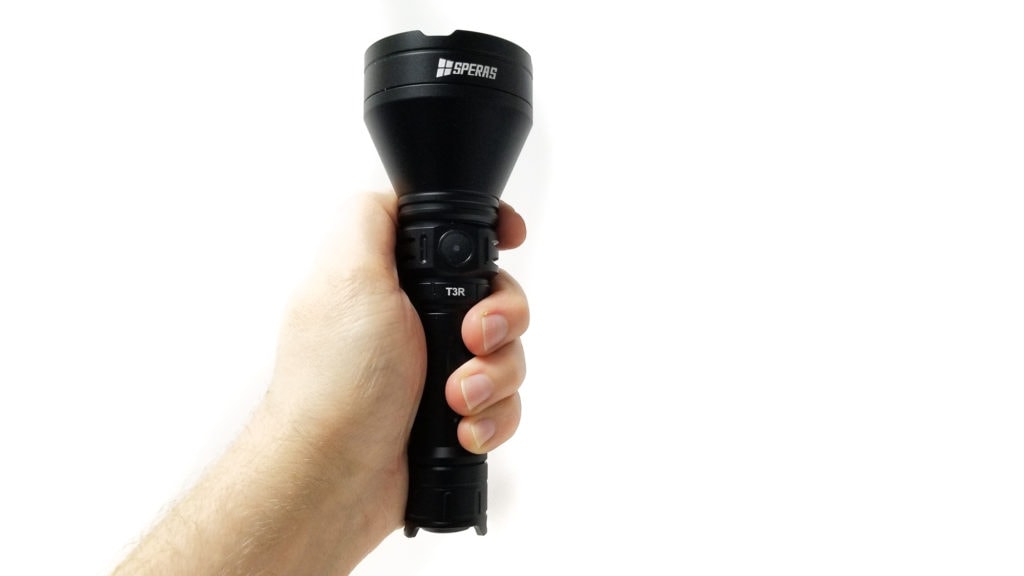
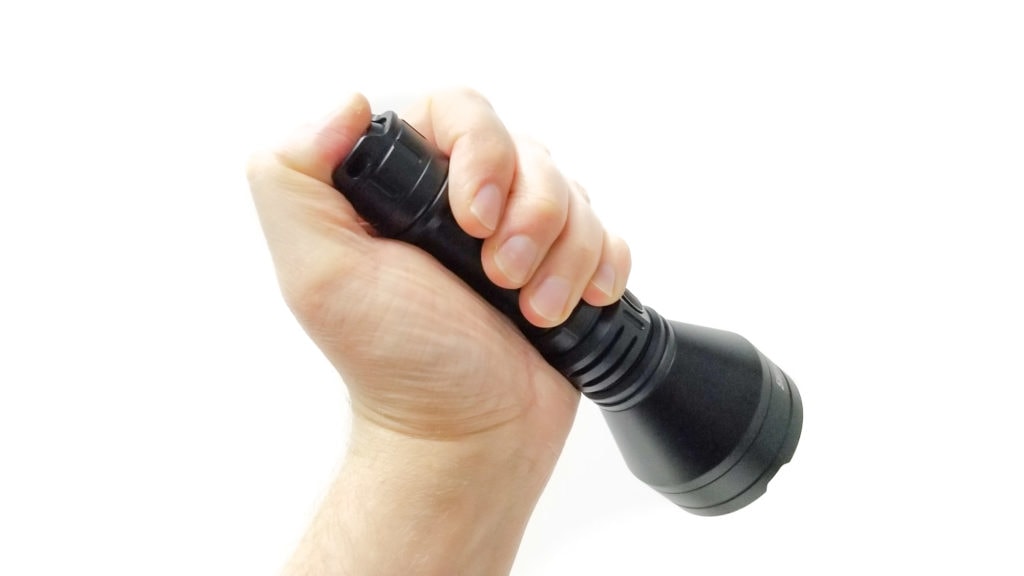
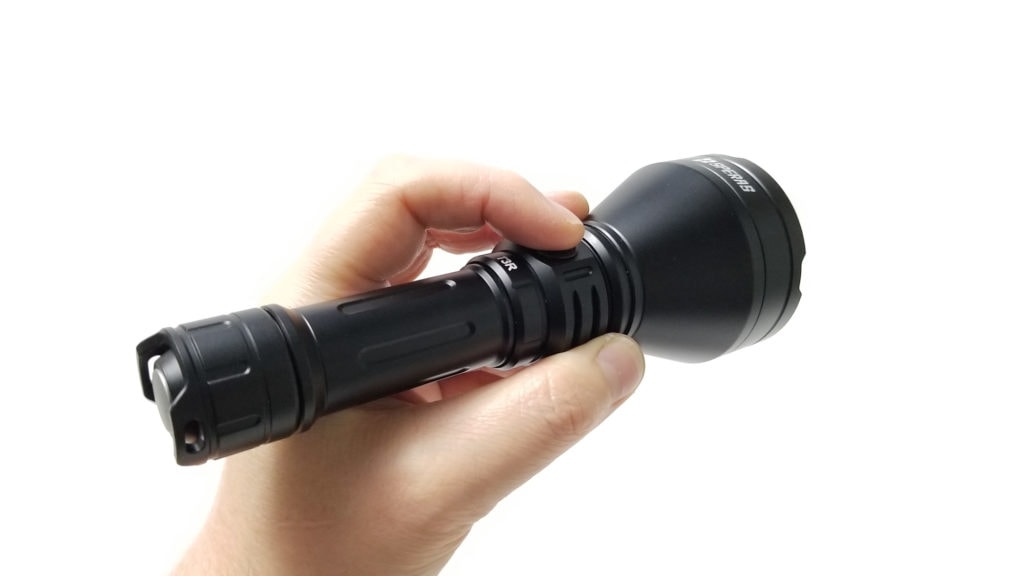
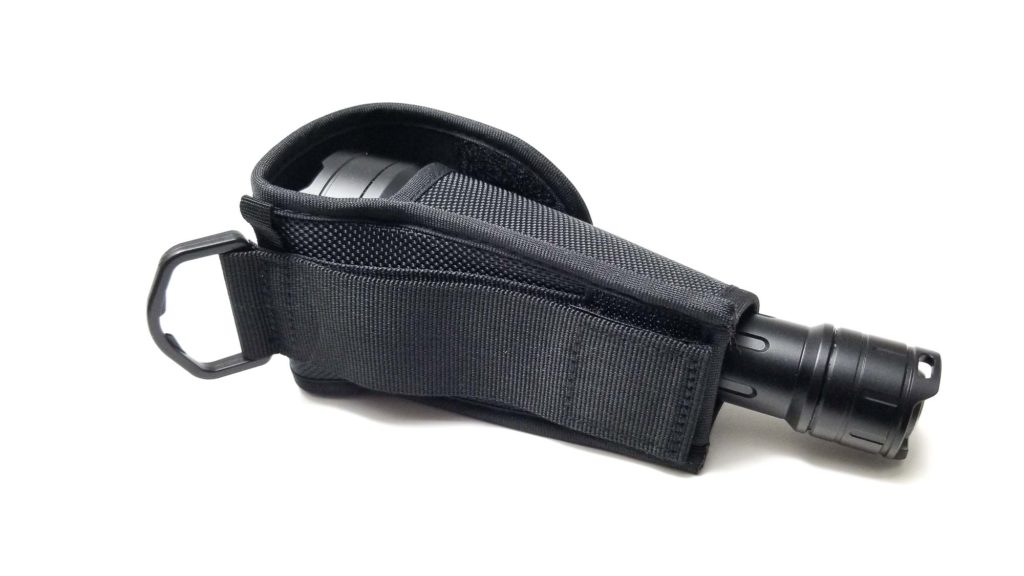
Build Quality, and Warranty
Speras lights are positioned somewhere between Nitecore, Fenix, Acebeam and Olight, and priced accordingly. The T3R runs about $130-$140 US, about the same as an Olight Warrior X Turbo and Acebeam T27, but cheaper than an Acebeam L19. Make no mistake, you’re getting a quality item with great build quality, fit, and finish. The light is milled from unspecified aerospace grade aluminum alloy, but it seems tough and sturdy. The part fit-up is great with no gaps or misaligned parts, and everything is tight as a drum and it passes my maracas test with flying colors.
The machining? Impeccable, even better than the Speras E3 I reviewed earlier, and all the edges are blended and chamfered to perfection. The charge port cover fits flush with the head and won’t snag on anything or open accidentally. The finish is a mix between semi-gloss and light matte type III HA. It’s expectedly perfect, with complete coverage and no defects whatsoever. It’s not as matte as I like, but not bad. It feels nice in the hand though.
The light is glued up tight, which is fine since you really wouldn’t need to get inside this thing and 99% of the folks who buy it won’t try anyway. The tailcap is removable to access the battery, and the light utilizes a signal tube like other rear e-switch lights. This is typical of dual switch lights, and unlike some of the competitors, the signal tube of the T3R is captured and unlikely to come loose or break off, so it’s not a failure point. The rear threads are very precisely cut rectangular units. They’re bare, very well-lubed, and ultra smooth. There’s a single generous o-ring sealing the tailcap, and Speras gives the T3R an IPX8 rating, so it should be guaranteed for temporary immersion down to 1 meter.
Speras Warranty: See www.speraslight.com
Speras has a great warranty and it’s comparable to the competition: Within 30 days, free replacement. SPERAS will provide 30 days free replacement service of purchase for any manufacturing defects if problems come into being in normal use; We will replace it with the same model. If the model has been discontinued, customers will receive a product with similar or improved model. Within Warranty time: Usually we provide 5 years warranty, some may provide lifetime limited warranty( for example E1). Within the warranty time, any defects please contact local dealer or distributor for warranty support. We will repair or we replace a new product for you according the defects. The free warranty does not cover any damages or failure caused by:Normal wear, rough operation, battery leakage.
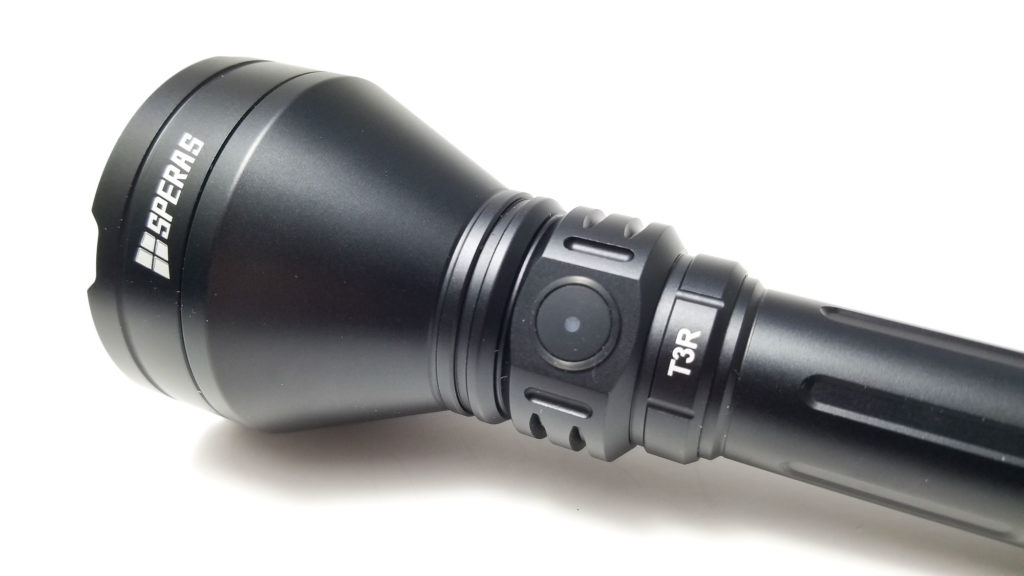
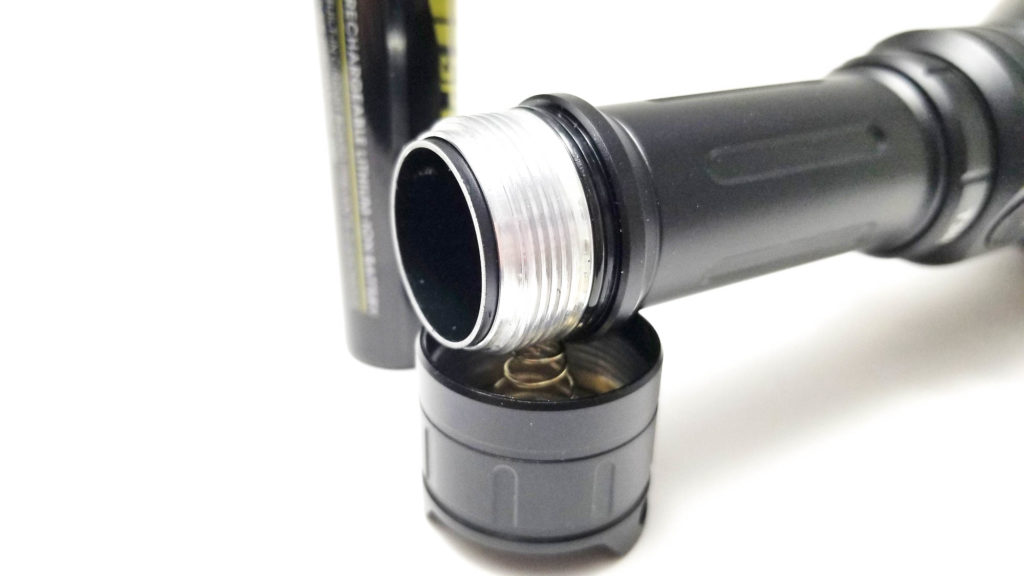
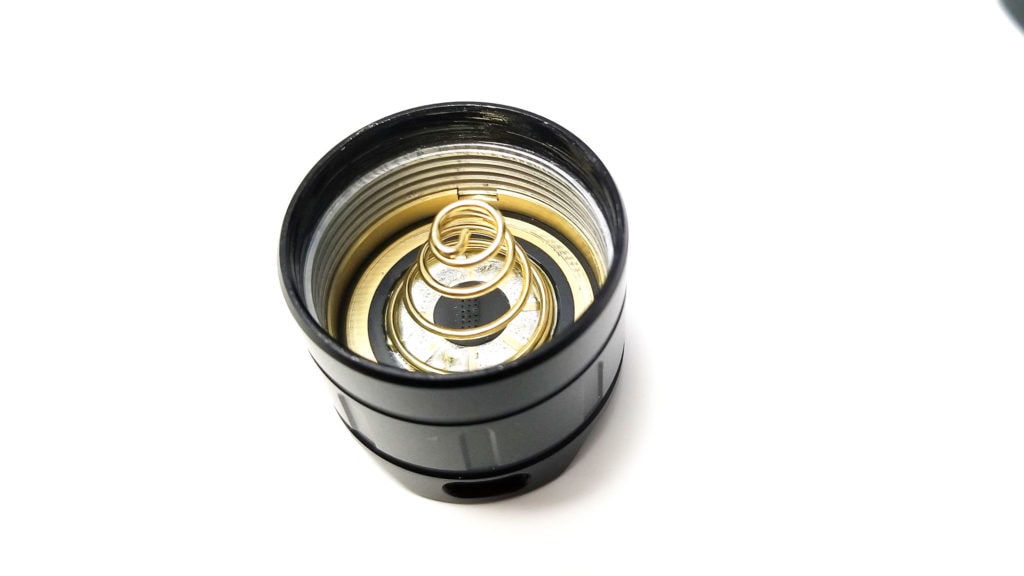
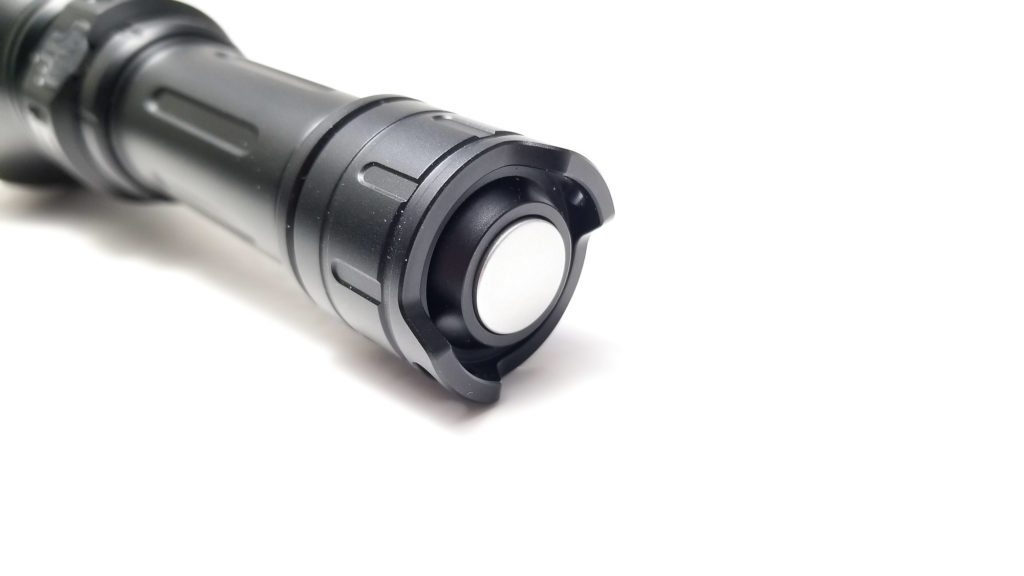
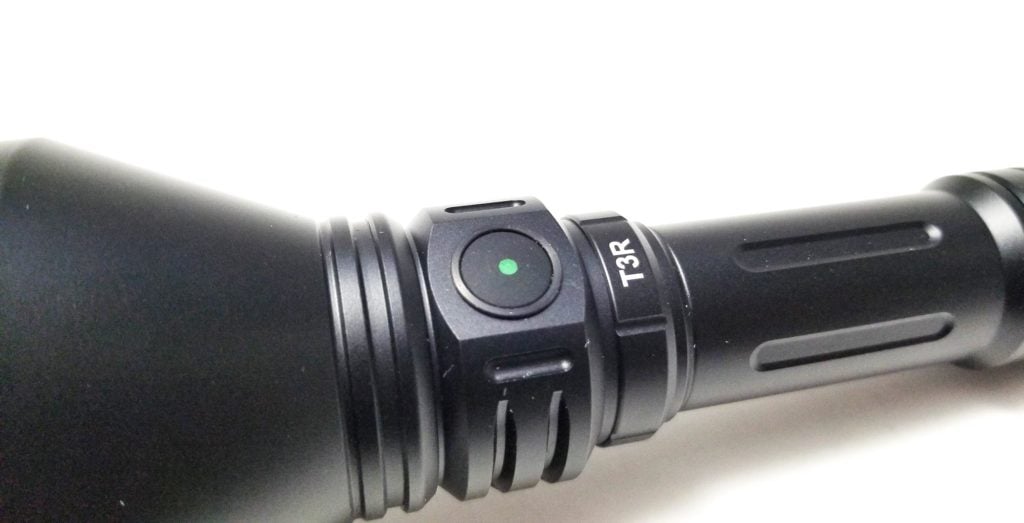
LED, Lens, Bezel, Beam, and Reflector
Speras calls the T3R’s emitter a “customized Luminus LED,” but discerning readers will instantly recognize it as the Luminus SFT-40-W. This is a domeless emitter with high cd/mm2 (nearly as high as the Osram Boost HX) which is great for throw, and although it shares the same 5050-footprint (5×5 mm substrate) of the SST40, it’s an entirely new design. It retains the bond wire design, but instead of 2, there’s 4, one at each corner of the LES, which measures around 4mm2. Thanks to the newer, more robust design, it’s just as bright as the SST40, but with the advantage, it can be driven a bit harder. An SST40 pops at around 9 amps, whereas the SFT-40-W can take much more. Head-to-head in a similar-sized reflector, the Osram Boost HX beats it in throw, but the SFT-40-W is capable of much higher output, in excess of 2000 Lumens if driven hard. This makes it a great choice for long-range throwers like the T3R, and the added output and larger hotspot help useability.
The reflector is a flawlessly smooth unit, with a deep cup and 7 mm emitter hole at the bottom. The LED is perfectly centered with a white centering gasket. The aluminum bezel has wide crenulations to allow light through, and the AR coated mineral glass lens is recessed about 7 mm below the edge of the bezel, so it would be well protected from drops.
The beam is all thrower, but it’s not the cleanest thrower beam I’ve seen, which is surprising for a higher-priced light. There’s a lot of spill, so that helps with side illumination, but the hotspot is surrounded by a ringlike outline that looks like an outline of the centering gasket. It’s visible indoors and outdoors, but it disappears at a distance though. Since this isn’t an EDC light, it doesn’t bother me that much, but on a premium light, I was expecting better. Aside from that, it’s a typical thrower beam. Like other Luminus LEDs, the SFT-40-W is a bit green at low settings, but it goes away at about the Medium mode. The tint uniformity is good, with indiscernible tint shift.
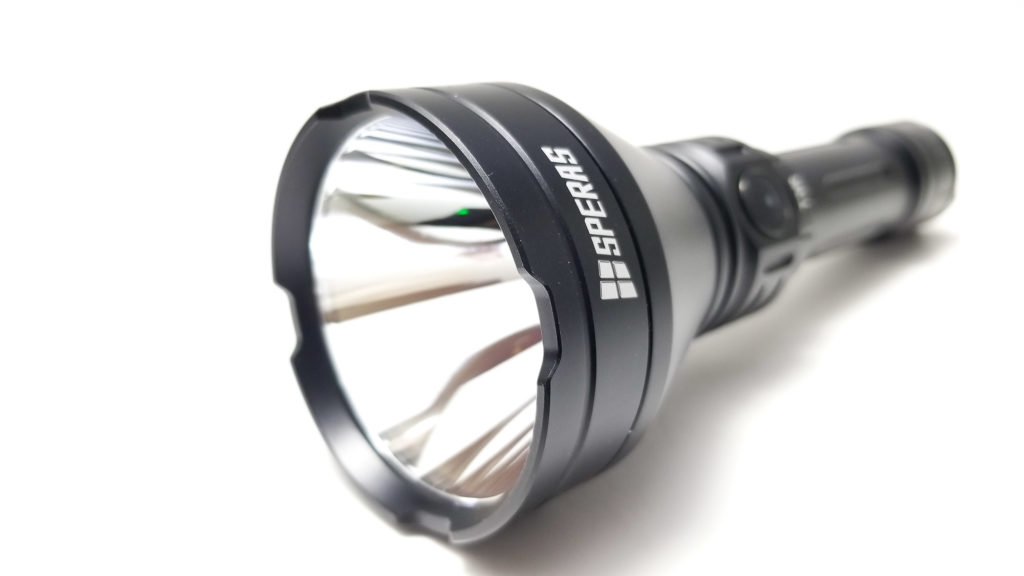
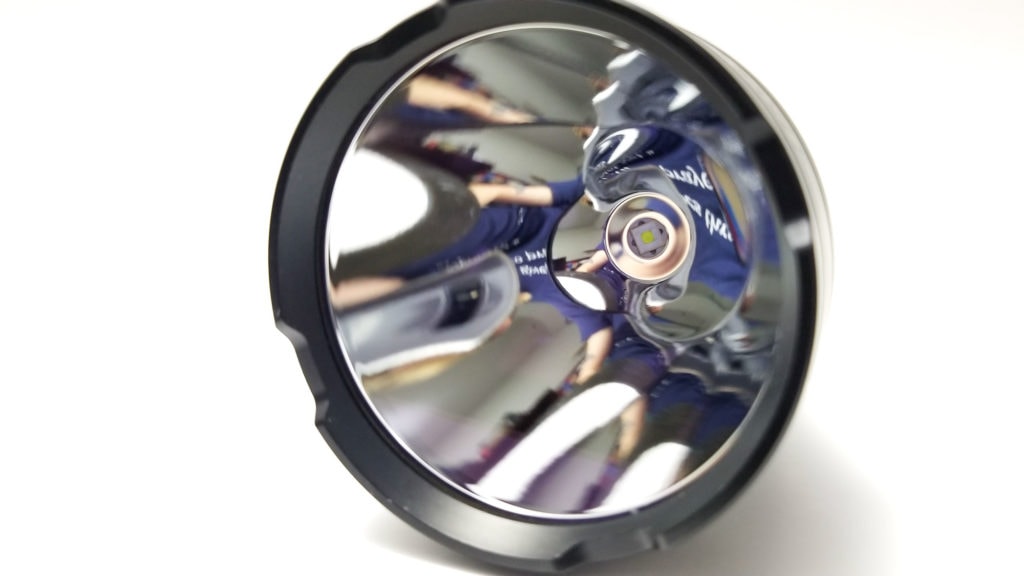
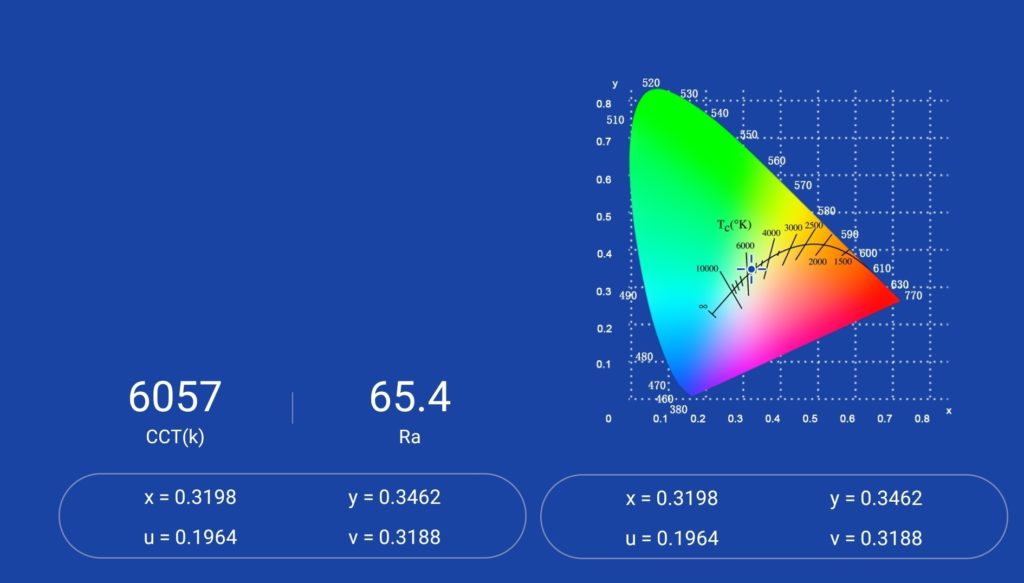
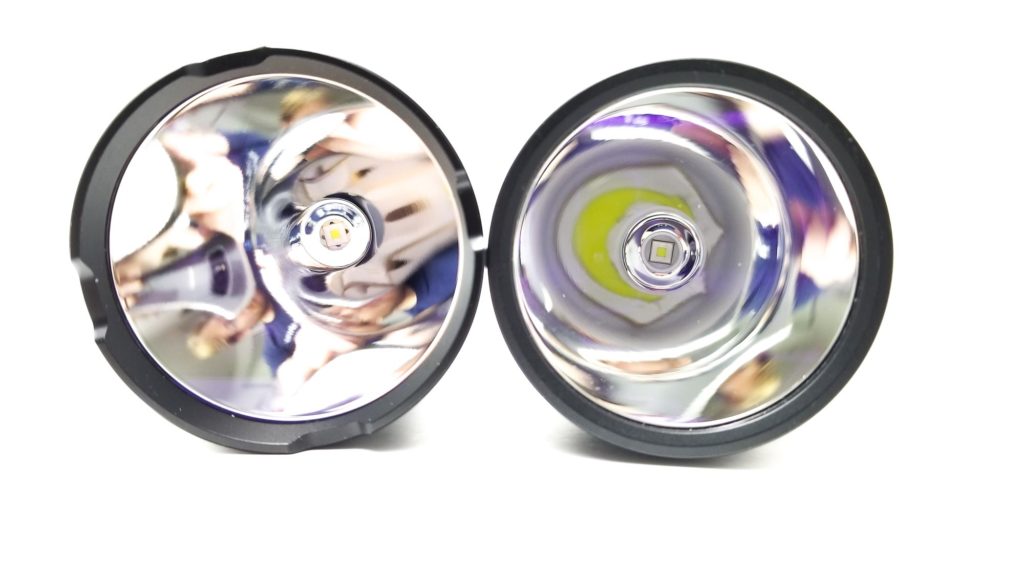
Dimensions and size comparison
- Length: 17.57 cm / 6.91 inches
- Head diameter: 6.36 cm / 2.50 inches
- Body diameter: 2.6 cm / 1.02 inches
Weight:
- Without cells: 253.6 grams / 8.31 oz.
- With cells: 308.6 grams / 10.88 oz.
Speras T3R competition comparison
I compared the T3R to some other similar-sized long-range tactical/duty throwers, and some general-purpose lights.
Group 1 left to right: Speras T3R, Convoy L21B, Acebeam L19, Acebeam L18
Group 2 left to right: Thorfire C8, Speras T3R, Speras E3, Cyansky K3, Fenix PD35 V3
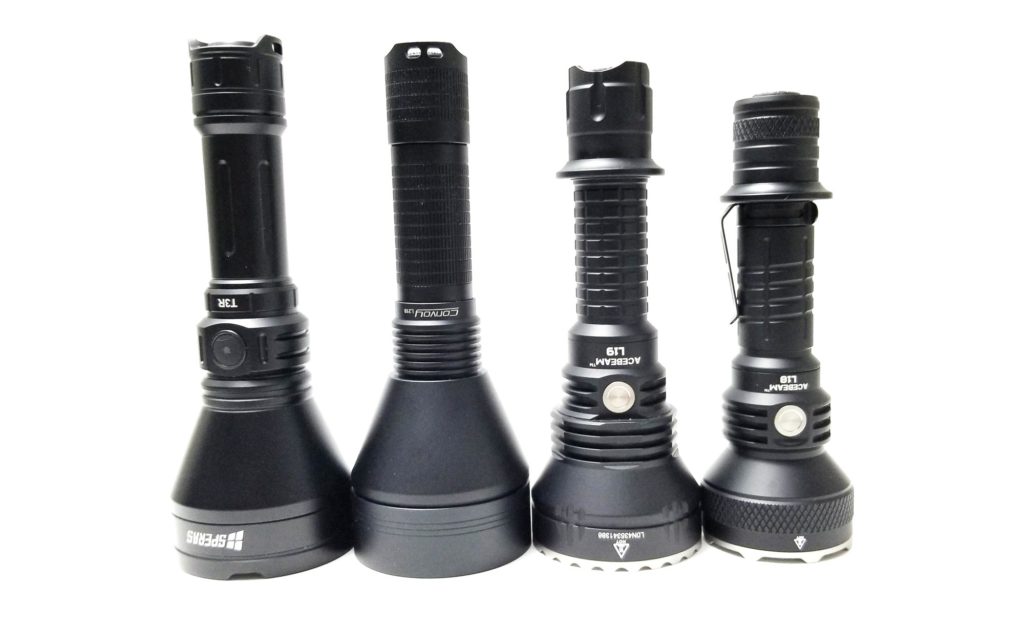
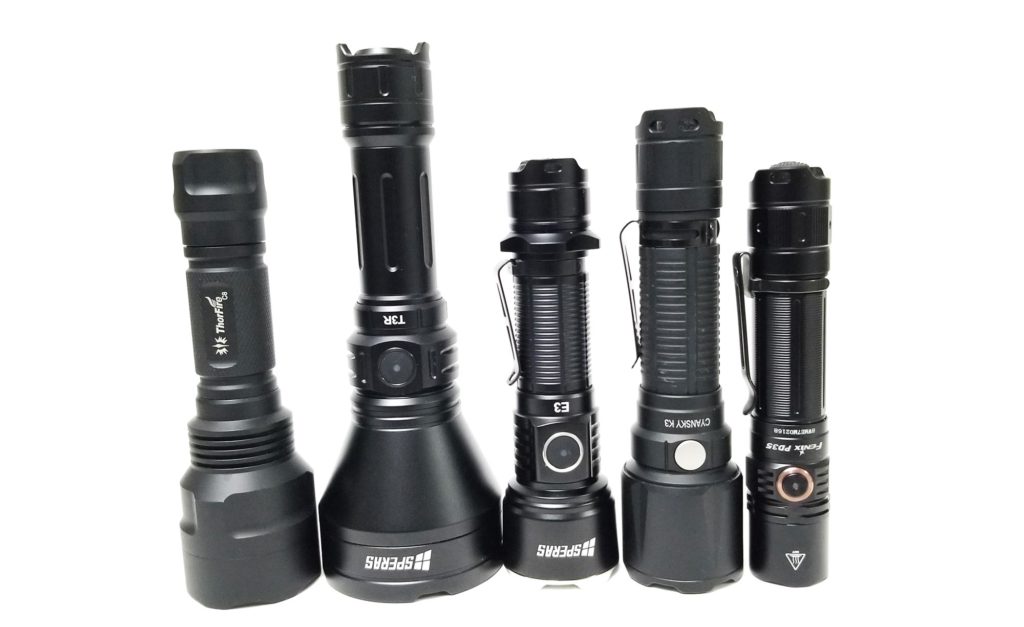
Driver & User Interface:
Speras makes no claim to the driver inside the T3R, but being as this is marketed towards professional users, it probably has a buck driver with constant-current regulation. This ensures consistent output throughout the battery’s useful capacity with long fully-regulated runtimes. These drivers are preferred on higher-end lights for that reason. Unlike an FET-driven light, the brightness doesn’t drop as the battery drains, but remains consistent until LVP (or the driver drops out of regulation).
The UI is an interesting one and cleverly designed around the dual switches. Each has its own unique function set, which I actually like. There’s mode memory, but it can be enabled/disabled with some button presses. The rear switch is typically for on/off, but works with the front switch for some other functions as well like the electronic lockout. The front switch is for switching modes and activating/deactivating the memory function. In true tactical form, the rear switch can be configured for instant High mode, and Strobe or S.O.S are available using the front or rear switch.
Available modes: Eco, Low, Medium, High, Strobe, S.O.S.
From OFF (front switch)
- Press and hold: Turns on in Eco mode
- Single-click: Turns on in last used mode
- Double click: Strobe (double-clicking again activates S.O.S.)
- 3 clicks: Turns on in Strobe for a split second then turns off
- 4 clicks: Turns on in Strobe for a split second, then turns off, then turns on in the last mode
From OFF (rear switch)
- Press and hold: Turns on in last mode (if memory enabled). If memory disabled turns on in High
- Single-click: Turns on in last used mode
- Double click: Strobe (double-clicking again activates S.O.S.)
- 3 clicks: Turns on in Strobe for a split second then turns off
- 4 clicks: Turns on in Strobe for a split second, then turns off, then turns on in the last mode
From ON (front switch):
- Press and hold: Turns off
- 1 click: Cycles through modes E-L-M-H-E-L-M-H-E-
- Double click: Strobe (double-clicking again activates S.O.S.)
- 3 clicks: Activates Strobe for a split second, then resumes the last mode
- 4 clicks: Activates Strobe for a split second, then switches to the next mode
From ON (rear switch):
- Press and hold: High mode
- 1 click: Turns off
- Double click: Strobe (double-clicking again activates S.O.S.)
- 3 clicks: Activates Strobe for a split second, then resumes the last mode
- 4 clicks: Activates Strobe for a split second, then turns off
Mode memory:
- Yes, and it can be activated or deactivated by pressing and holding the front switch for about 10 seconds in any state until the light blinks and the switch LED blinks green (memory activated) or red (memory deactivated)
Shortcuts:
- To Eco: Press and hold the front switch from off
- To Strobe: Double click front or rear switches
- To S.O.S: Double click in Strobe
Low voltage warning:
- The front switch LED shows battery state during operation: Green for ≥70%, orange for <70%, Orange LED, and red for<30%. For ≤10%, the red LED will start flashing until the light shuts off.
Strobe/blinkies
- Yes, Strobe and S.O.S. To activate in any state, double click for Strobe and double click again for S.O.S.
Lock-out mode:
- Yes. Press and hold the front switch and rear switch simultaneously for 2 seconds to activate the lockout. The lockout can be deactivated by triple clicking the front or rear switch three times
PWM
- Nope
Additional info on the UI:
As far as professional-use UIs go, this is a good one and easy for just about anyone to master, but there is a learning curve to it. All the necessary functions are present here without the superfluous fluff that comes with enthusiast UIs like Anduril/Anduril2 or NarsilM. There’s nothing wrong with those, but for regular folks, this is important since most users won’t bother with calibrating a thermal sensor and won’t care if they can switch on or off the switch LED, or change the brightness levels in smooth ramping. They want a light that turns on, off, and switches modes easily. The Speras T3R does that well, and I like the added features including the ability to turn off mode memory which can be useful in tactical applications, and the fact that electronic lockout is available, but is not easy to accidentally activate. I’m not a fan of the press-and-hold to turn it on (I think this should be done with the tail switch), but it’s nice to see instant High mode available (even if it’s not a true forward switch).
Batteries & Charging
The Speras T3R steps into the 21st century with 21700 power, which is becoming increasingly common these days.The T3R ships with Spearas’ S50, which is a 5000 mAh protected battery (overcharge, overdischarge). No claim on current-handling is made, but it’s adequate to handle the sub 10 amp current demands of the light. You can also use any 21700 that fits, since there’s no proprietary or ‘customized’ batteries here. You’ll need a button top protected cell since standard flat tops are too short. There’s onboard USB type C charging as well, set at 2 amps maximum so it should take about 3.5 hours or so to charge the battery. My USB tester showed about 1.7 amps, which is reasonable and accounts for losses in the charging circuit buck converter. C to C charging? No problem as the T3R charged at the same rate as USB A to C.
Speras also added power bank capability by means of the included USB OTG (on the go) dongle adapter. It’s a male USB type C connector on one end, and a USB A socket on the other for plugging in a USB cable (also included). The adapter is far superior to the ones included in other flashlights with this capability since it will work with any USB type C female socket. Just insert the adapter into the power source and plug in a USB cable into the other end and you’re good. The powerbank is also set at 2 amps, and my USB tester was up and down in this regard, and not too impressive, ranging from about 350 mA to 1.3 amps output depending on the device being charged. The T3R charged the Sofirn SP36 Pro Anduril 2, and it worked with the USB C rechargeable Acebeam 21700s as well.
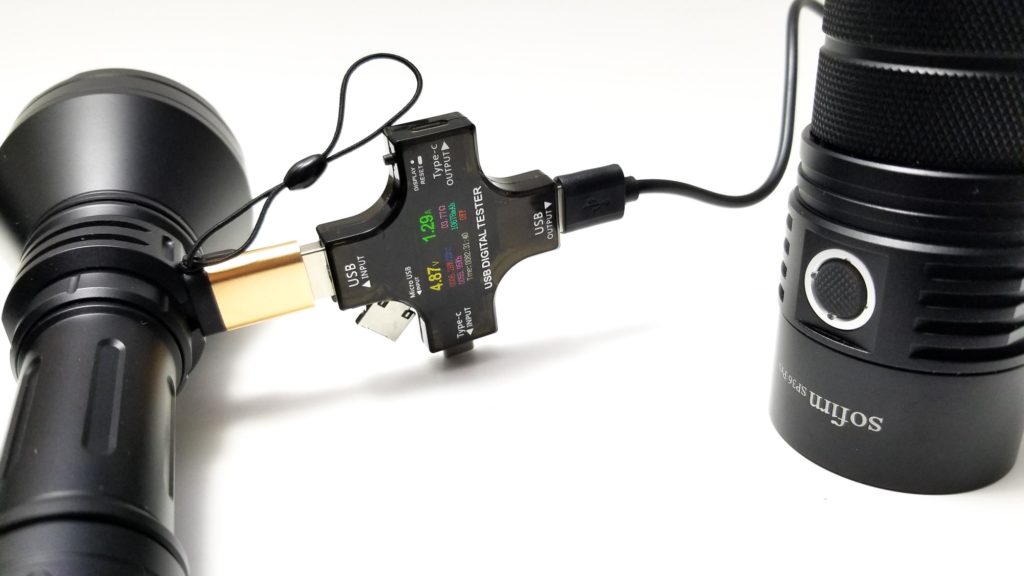
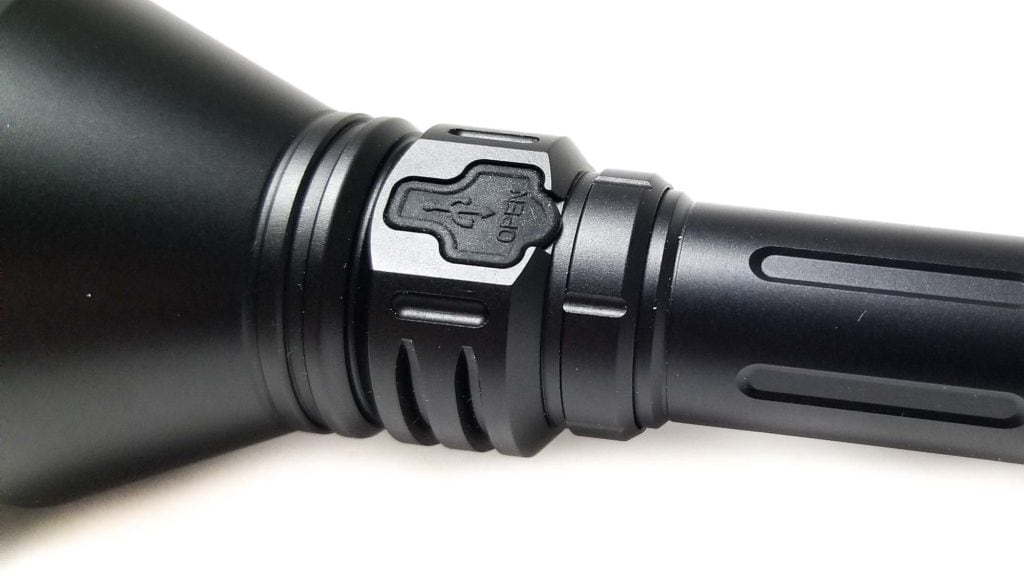
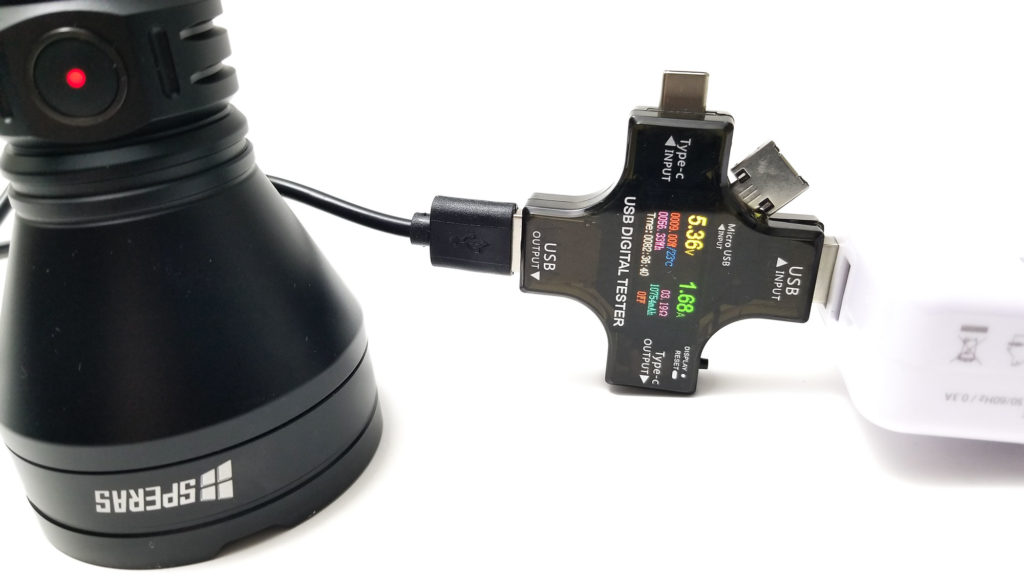
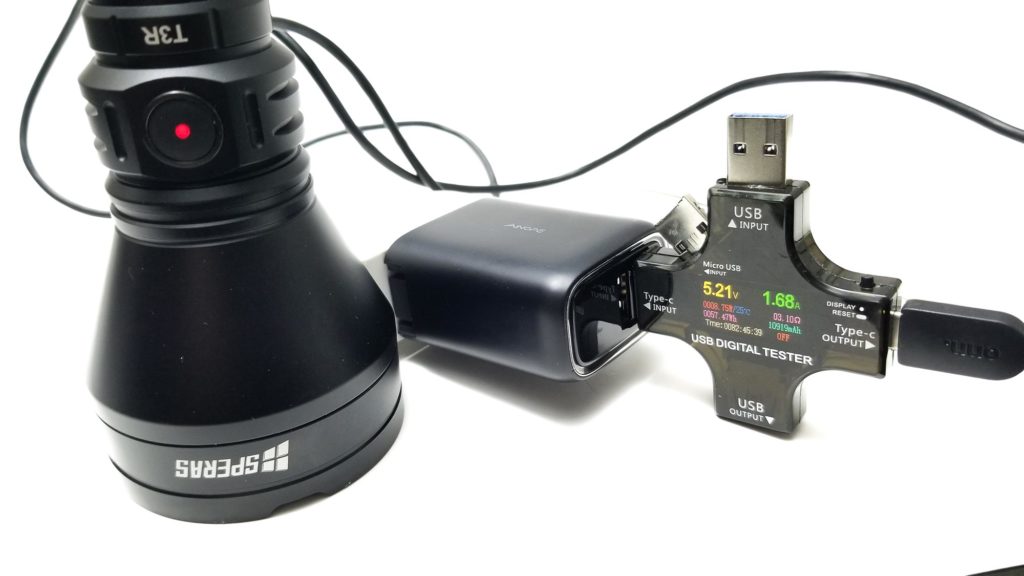
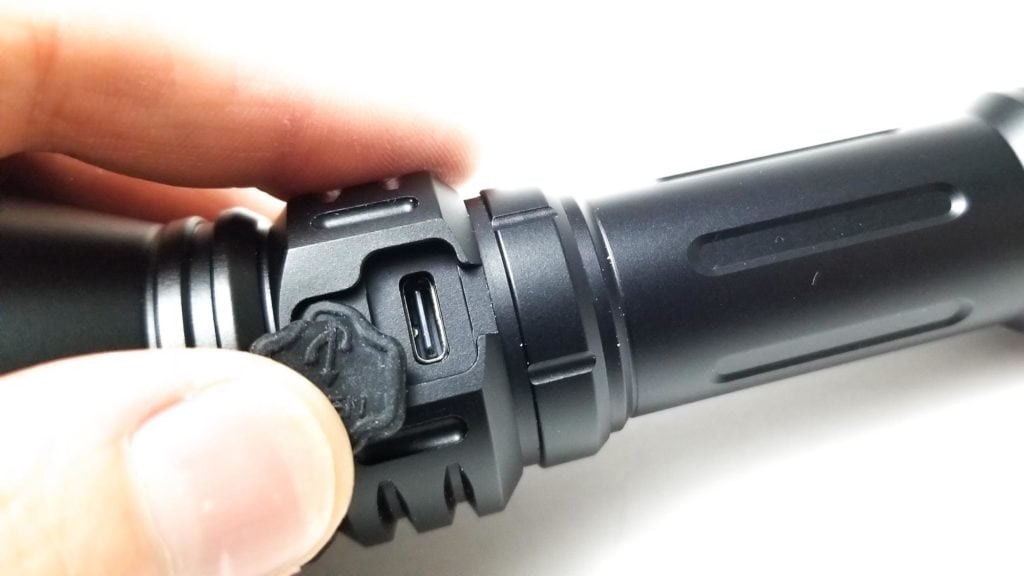
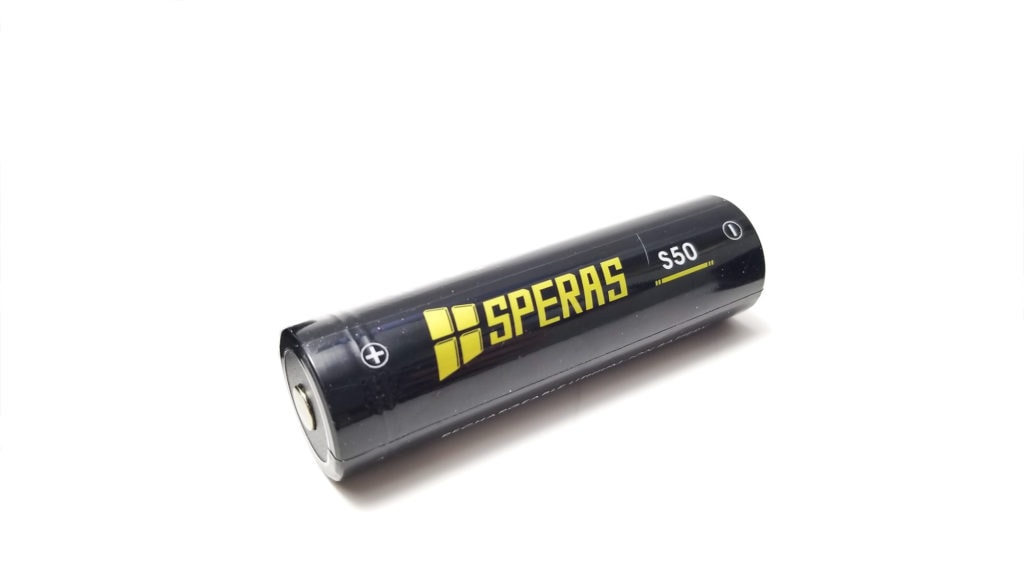
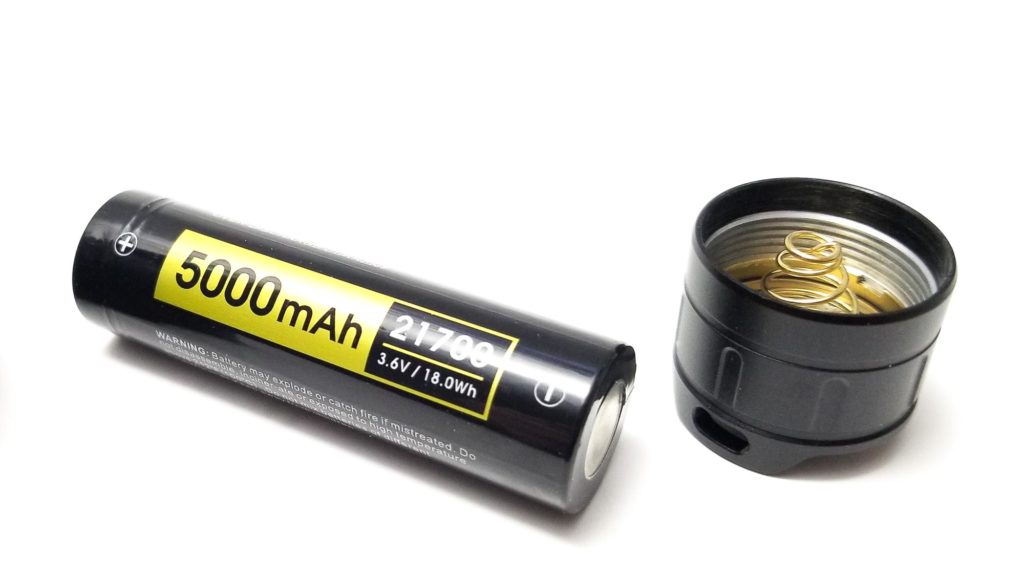
Performance test
Lumen measurements (for each mode)
Lumens are measured using my home made 30 cm integrating sphere, and I use a Digi-Sense 20250-00 datalogging luxmeter. The sphere has been calibrated using many lights of known output, including a Makkua calibrated Convoy S2+. All measurements taken at 30 seconds and I used the included fully charged Speras S50 battery. Amps are measured using my Radio Shack T-RMS digital multimeter with 16 gauge wires directly in the meter for current under 8 amps, and my FY2019 clamp meter with a loop of 12 gauge wire for currents over 8 amps.
| Mode | Amps at start | Specs | turn on | 30 sec | 10 minutes |
|---|---|---|---|---|---|
| Eco | 56 mA | 20 | 23.24 lm | 23.24 lm | – |
| Low | 300 mA | 120 | 123 lm | 123 lm | 123 lm |
| Med | 1.30 A | 600 | 638 lm | 636 lm | 622 lm |
| High | 6.19 A | 1600 | 1680 lm | 1624 lm | 812 lm |
Parasitic drain:
- 2.2 µA
Runtime graph
I tested the runtimes in the 30 cm integrating sphere using the Digi-Sense 20250-00 datalogging luxmeter. I used the fully charged Speras S50 battery and tested Low, Medium, and High modes.
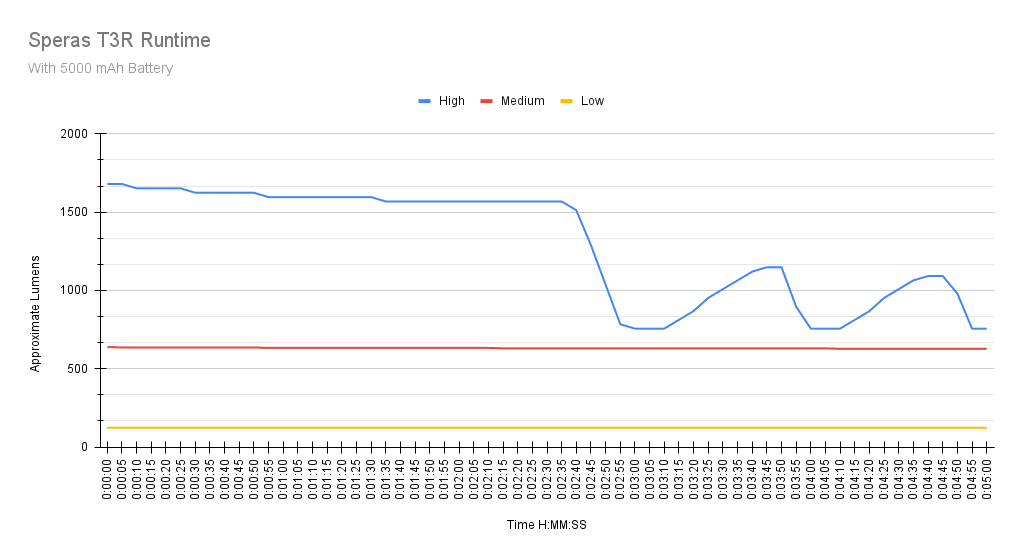
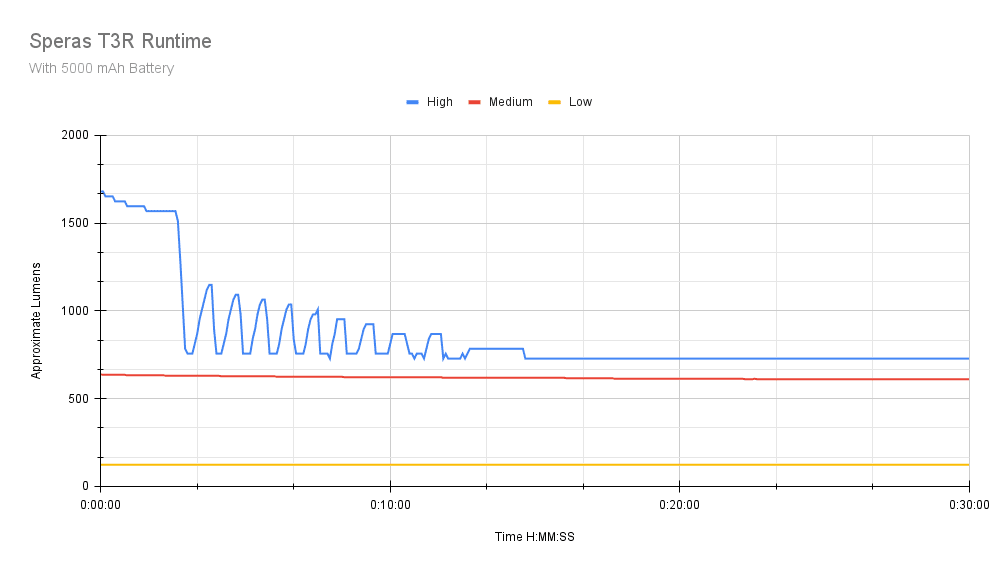
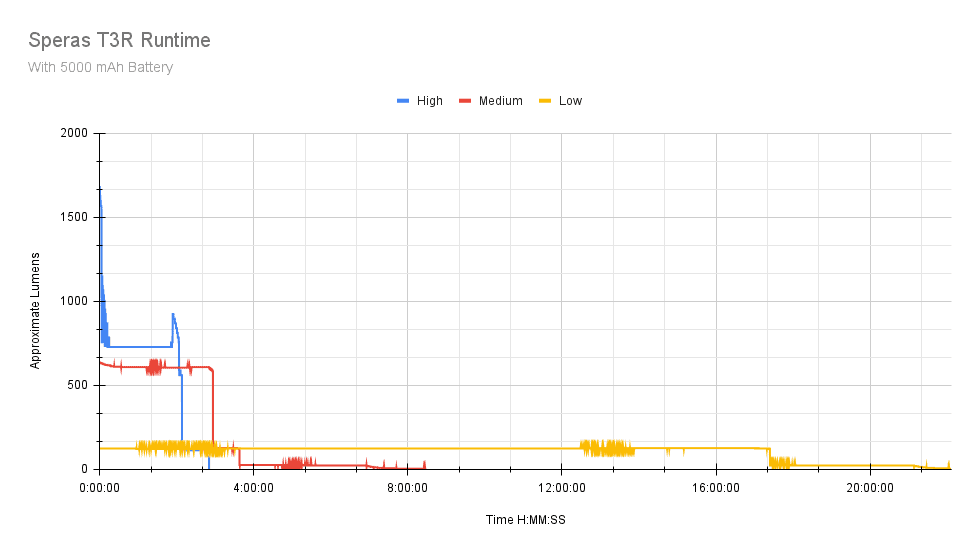
High started at 1680 Lumens, and the sustained output was pretty decent, holding better than 1600 Lumens for almost 55 seconds, and better than 1500 for over 2 minutes. At the 2 minute 35 second mark, there’s a step down to 1288 Lumens, then another drop to about 800 by 3 minutes. After that the output increases slightly, then back down again as the see-saw thermal regulation commences. This lasts for about 10 minutes, and unfortunately, it’s obvious and visible to the naked eye. At the 12 minute 40 second mark, this nonsense settles down and the output is consistent at around 700 Lumens until the 1 hour 53 minute mark when the output shoots up to almost 1000 Lumens for a couple minutes before dropping back down and settling at around 100 Lumens as LVP pulls the reigns back. The light shuts off at the 2 hour 50 minute mark. Speras specifies 2.1 hours, so I handily beat that. I’ll take it! The battery was discharged pretty deep though, down to 2.56 volts. Heat was not an issue. Never reaching over 45 C and the light was always hand-holdable.
Medium started at 638 Lumens and was rock-solid for quite a while. It held 600 Lumens or better for almost 3 hours, and didn’t start noticeably dropping output until the 2 hour 56 minute mark when it dropped to under 150 Lumens. This lasted about an hour and 20 minutes, then another deep drop to under 30 Lumens at 3 hours 38 minutes, then shutdown at 8 hours 26 minutes. Speras gives you plenty of time to switch or change out that battery! Heating wasn’t an issue here either, barely going over about 5 C ambient. The highest temp? Just 26 C. Spec’d runtime is 3.75 hours, or 3 hours 45 minutes. Again, Speras is measuring the runtime to the first step down.
Low was actually unintentionally tested, but shows just how well-regulated this driver is. The test started at 123 Lumens, and ran…and ran, and ran…and ran some more. In fact, the first step down happened at 17 hours 24 minutes into the test when the output dropped to 22 Lumens like High and Medium. I let the test continue to run and 5 hours later, the light shut down. Total runtime was 22 hours 5 minutes. Speras says Low should last 17 hours 30 minutes, and again, they’re probably basing this on the first step down.
Once again, we see the merits of a buck driver with long, fully-regulated runtimes. This is the type of performance a professional user needs since the brightness doesn’t drastically decrease as the battery dumps. The brightness stays stable until the battery can’t supply sufficient voltage to keep the MCU/buck regulator running and it drops out of regulation. The light isn’t being driven too hard, and it has a good amount of thermal mass to help with keeping the temperatures down, but that thermal management. Yes, it’s limited to High mode, but it’s the icky sawtooth type I observed on the E3 I tested, and like we used to see on Sofirn’s first-gen ATR. To be fair though, it’s not too noticeable (unless you’re paying attention…or watching a runtime graph), and it only lasts for a short time. The light stays comfortable to hold the entirety of the High test, but the battery is discharged a bit too deep for my liking at between 2.65 and 2.5 volts. The light was also usable after each test, albeit in short bursts.
Throw numbers:
Throw was measured using the Uni-T 383S luxmeter at 10 meters outdoors. Readings taken at 30 seconds. I used the fully charged Speras S50 battery for the test.
| Mode | Specs | Candela measured | Meters | Yards |
|---|---|---|---|---|
| Eco | 4350 cd, 132 m | 4200 cd | 130 | 142 |
| Low | 19,500 cd, 279 m | 19,000 cd | 276 | 301 |
| Medium | 109,250 cd, 661 m | 93,000 cd | 610 | 667 |
| High | 300,000 cd 1,095 m | 293,800 cd | 1,084 | 1186 |
I am not complaining one bit about these numbers! Impressive for a 60 mm head that pushes almost 1700 Lumens. This is more than enough throw for most users and easily illuminates objects 200+ meters distant.
Beamshots
I tested the T3R against some other long-throw flashlights including the Acebeam L19 (about 1300 m throw), L18 (around 1000 m throw), L17 (about 800 m throw), Convoy L21B (about 1100 m throw), and Cyansky K3 (aout 600 m throw). For fun, I threw in the WildTrail WT90, which I measured at a bit over 1700 m of throw.
I measured the tower via Google Maps and it’s about 950 m away. My camera can’t zoom in all the way, but the light is definitely hitting the tower.
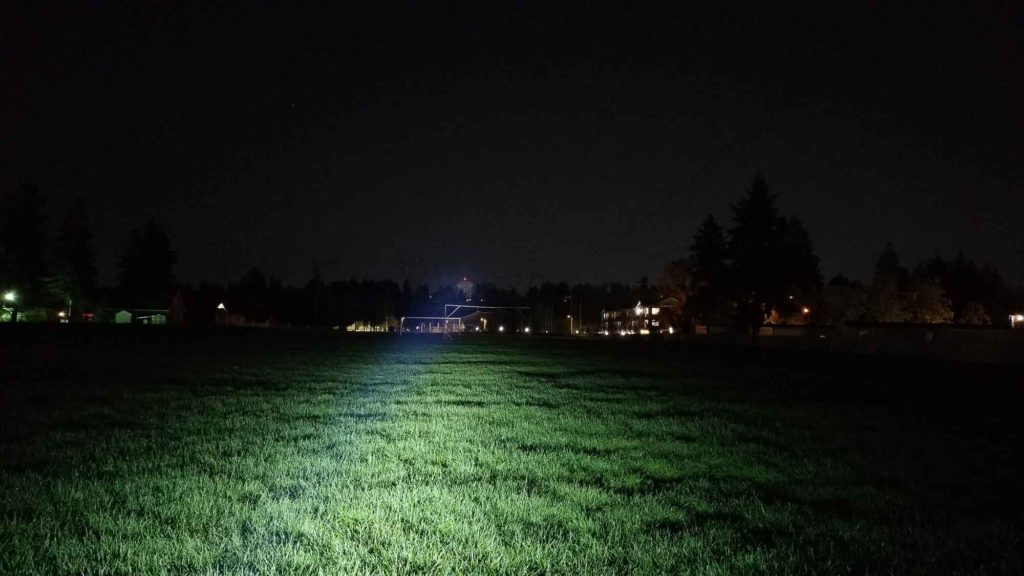
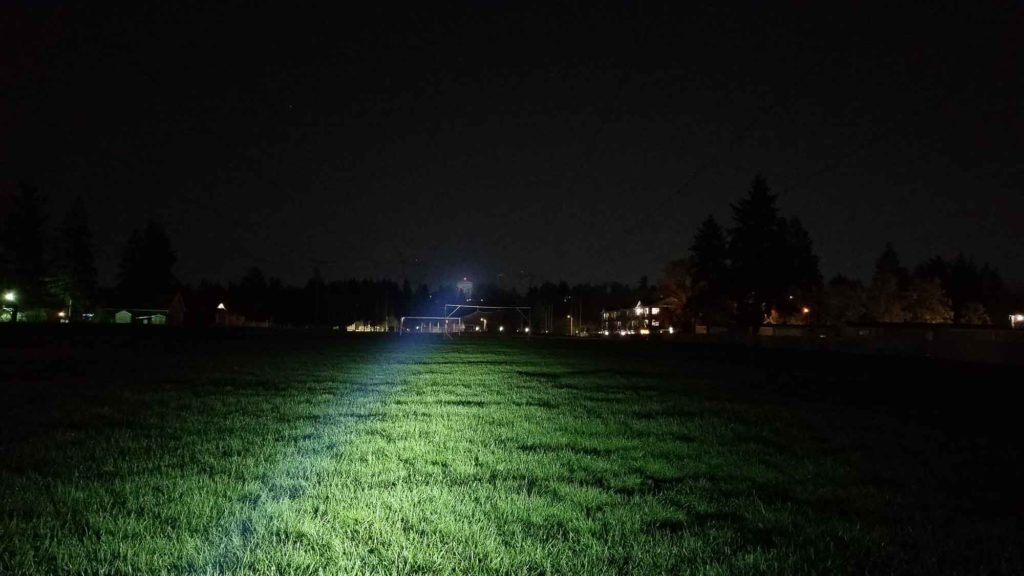
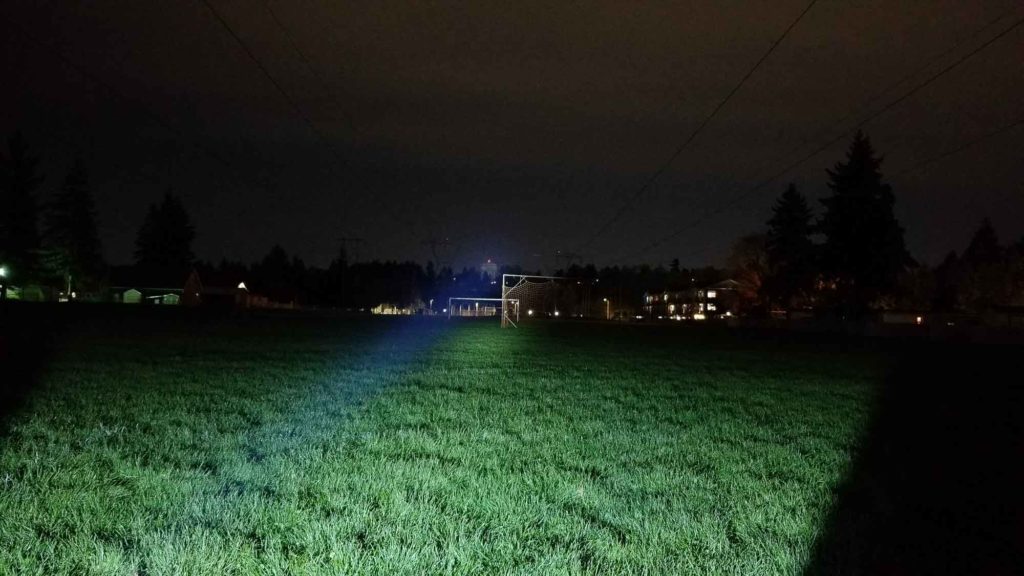
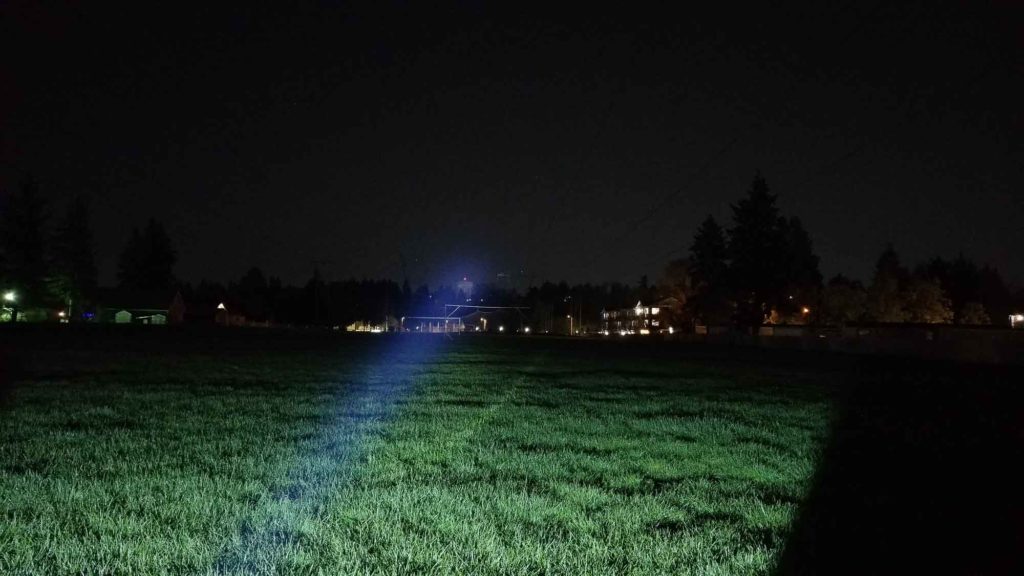

Disclaimer: This flashlight was sent to me for review at no cost by sperasflashlight.com. I have not been paid to review, nor have I been holding back on problems or defects.
Final Verdict
Pros
- Excellent build quality
- Well regulated buck driver
- Great throw and good output
- Onboard charging + power bank
- Includes lots of accessories and battery
- Interesting dual-switch UI
Cons
- Artifact-ridden beam
- UI is a bit unusual for a duty/professional use light
- Too-aggressive thermal management on High mode
- Finish is a bit slippery
Explanation on star ratings:
1: Avoid: my phone flashlight would be a better choice – 2: Poor: significant defect or issues; almost unusable – 3: Average: some defects or issues; but still usable 4: Good: recommended (minor issues) – 5: Great: highly recommended

4 stars: ★★★★
There are tons of good flashlights out, and just about every manufacturer makes a long-range midsize thrower with a roughly 60 mm head. You can spend a lot, or a little, and there’s something for every budget. If you’re looking at an Olight, Nitecore, Fenix, or Acebeam, consider the Speras T3R. It’s a solid contender in its segment for sure, and I really like the pro-level feature set like the nicely regulated driver, added power bank feature, and the addition of the SFT-40-W LED.
Once again, I’m coming away impressed with the overall quality and finish of Speras products. This is a fully-featured light that would be equally at home mounted on a hunting rifle or riding on a duty belt, ready for inspections and long-range observing. Although it would be less-useful as an EDC or general purpose light, despite the somewhat-compact size. I wished the beam was a little tidier, and the UI is…a bit odd for a light in this classification. I’m not a fan of the a bit-too-aggressive thermal management on the High mode either.
Lastly, I can’t talk about the T3R and not mention the Convoy L21B. There’s a pretty interesting contrast between the two lights, almost like Speras took an L21B and said, “hey, let’s add a side switch, onboard charging, and ditch the mech for an e-switch.” I like the result, but all that tinkering has added about $90 to the price of the standard L21B, which is still a very high quality flashlight. It almost begs the question: If you don’t need onboard charging or a side switch, why buy the Speras? Anyway, I digress, if you’re looking for a pro-grade light that has good runtimes, solid build quality, a nice driver, and charges your USB devices as easily as it will light up far-away things, the T3R is a compelling choice, but not a stand-out. I give it 4 stars.
Speras T3R For Sale
1lumen selects and reviews products personally. We may earn affiliate commissions through our links, which help support our testing.